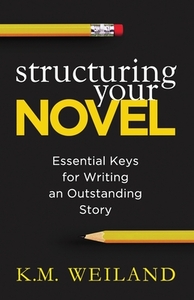Take a photo of a barcode or cover
120 reviews for:
Structuring Your Novel: Essential Keys for Writing an Outstanding Story
K.M. Weiland
120 reviews for:
Structuring Your Novel: Essential Keys for Writing an Outstanding Story
K.M. Weiland
A detailed yet easy to understand guide to story structure. I haven't read up on the craft of writing like I ought to have, and this book was a good way to help get me started. I was able to label parts of my novel with different sections of the structure, and it helped a lot to know where things go and when they need to happen. The book takes you through each "level" of the story, guiding you in knowing what needs to happen where, and how it could happen. Weiland discusses scenes and their sequels, which was also helpful to me, especially since I'll be needing to restructure and better plan my fantasy novel. I know now how I can do that, so writing it won't explode in my face. ;)
The book started off strong with solid advice. It did a great job of organizing some simple, yet crucial details. Somewhere around part three is about structuring your sentence and that's where it started to drag for me.
informative
medium-paced
The discovery of story structure was extremely eye-opening to me. In ‘Structuring Your Novel’ K.M Weiland gives you the tools that you need to craft a story from idea to manuscript. She covers the subject in detail, providing a multitude of real-world examples at every step along the way. Weiland then proceeds to detail scene structure what was equally eye-opening for me. If story structure gives you the tools to create your overview, then scene structure shows you how to put each nut and bolt in place. Finally we delve down to the sentence level to help us flesh out our scenes.
If I were to recommend just one book on writing to any aspiring author it would be this one. In its pages you will find the lessons that every writer needs to learn. My own writing has improved dramatically from these lessons. I give this book my highest recommendation to anyone who wants to know how stories are put together.
If I were to recommend just one book on writing to any aspiring author it would be this one. In its pages you will find the lessons that every writer needs to learn. My own writing has improved dramatically from these lessons. I give this book my highest recommendation to anyone who wants to know how stories are put together.
After struggling for an entire year trying to write my novel, I read this book. I re-read it. I took notes. Then I locked myself in a hotel room for 2 days and wrote an outline for a 30 chapter novel.
This is the HIGHEST praise I can offer. For once I read a how-to and it delivered!!!!
#NANoWriMo folks, this is a MUST READ. <3 <3 <3
This is the HIGHEST praise I can offer. For once I read a how-to and it delivered!!!!
#NANoWriMo folks, this is a MUST READ. <3 <3 <3
While I found this book interesting enough, it was way too prescriptive for my liking. I've been finding more and more that KM Weiland likes to tell you that her way of writing is the only way of writing, and this book especially is bad about that. This isn't a book about structure, it's a book on how KM Weiland approaches structure. Turns out she's extremely fond of the "Hollywood" standard of writing, which clings WAY too steadfastly to its precious three acts, and she's very quick to tell you that if you deviate from those three acts your book will fail, which is by no means the case. I would have liked this book much more if she had explored the many variations on structure that exist rather than only presenting the three acts and leaving it at that. I guess I'm just tired of hearing people hand out rigid advice that encourages writers not to experiment with writing. Too many writers are more concerned with marketability than they are with telling a story and it's sad to see so many people accept their word as fact.
I'd rate the first half of the book at 5*. It's a really good plot structure overview, listing all the key points you need to hit in a novel to create compelling structure. HOWEVER, in the second half of the book, when the author gets into Scene & Sequel, the breakdown of structure gets FAR too prescriptive for my tastes. The author claims that you can break from the structure, but at the same time, she continuously pushes the point that you MUST have points A, B, and C to each scene and each sequel, or your story will fall apart. Personally, I found the latter half of the book's advice too formulaic, despite the author's insistence that it wasn't. So I recommend the first half of the book for a good primer on overall story structure. The second half of the book takes everything good about the first half and turns it into utter monotony.
i got into this because i was listening to weiland’s podcast (highly recommend for writers!!!), and i have to say i really enjoyed it. i think it made a few things clearer for me, and i was glad to read a writing craft book that wasn’t either too succinct or too wordy. this is the nice in between, and it makes clear what it’s trying to say, rather than losing you between five different examples.
i think this is a good refresher, and if you’ve read other writing craft books, this is the perfect one to put it all together and reference back to. i have it highlighted out the wazoo for easy note taking and referencing and it’s making my drafting process a breeze.
i think this is a good refresher, and if you’ve read other writing craft books, this is the perfect one to put it all together and reference back to. i have it highlighted out the wazoo for easy note taking and referencing and it’s making my drafting process a breeze.
An excellent guide full of practical knowledge about story and scene structure, including helpful examples from successful stories. Easily applicable advice sure to strengthen any narrative. While much of this is intrinsic to anyone with writing experience already under the belt, it's still useful to see it laid out in a clinical and understandable manner. I'd recommend it to beginning writers especially as I wish I'd had this book when I first started writing novels. It would have saved countless structure/plot hole headaches!
Like many people, I have an intrinsic grasp of plot and structure, but I find it hard to articulate how it works, and even harder to apply it to my own stories. This book is really helpful in breaking plot down to its bare bones, and explaining how it all works. What exactly does a three-act structure entail? What is the purpose of the first plot point, and when should it occur? It also gives hand-on examples from famous films and books. I also found the second part, in which the author explains the structure of scenes, quite helpful.







